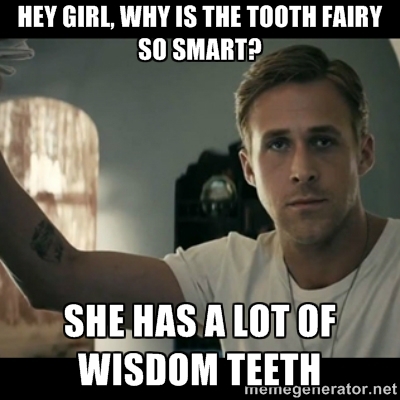The Mysterious Tooth Fairy
 As a child, I had no illusion that Santa Claus or the Easter Bunny were real. The tooth fairy, on the other hand, was a fantasy figure I never doubted. The idea that someone wanted my baby teeth and would even pay for them thrilled me! As a dental student now, I got the opportunity to be the tooth fairy on our rotation at Children’s Hospital Healthy Smiles Clinic. It was interesting to see which kids believed in her and how much money they’d expect to receive. The answers varied from child to child and their excitement for her visit did as well.
As a child, I had no illusion that Santa Claus or the Easter Bunny were real. The tooth fairy, on the other hand, was a fantasy figure I never doubted. The idea that someone wanted my baby teeth and would even pay for them thrilled me! As a dental student now, I got the opportunity to be the tooth fairy on our rotation at Children’s Hospital Healthy Smiles Clinic. It was interesting to see which kids believed in her and how much money they’d expect to receive. The answers varied from child to child and their excitement for her visit did as well.
The tradition of rewards for baby teeth is believed to have originated in Europe during the Middle Ages. Exfoliated baby teeth were buried, and when the child’s sixth tooth fell out, the parents would slip a gift or money from the tooth fairy. In northern Europe, a tooth fee was paid when a child lost their first tooth. In England, children were often instructed to burn their baby teeth in order to save themselves from hardship in the Afterlife. Finally, the Norse culture believed that children’s teeth brought good luck in battle.
The representation of the tooth fairy we know today didn’t develop until much later. The earliest reference to the tooth fairy in modern times was in the Chicago Daily Tribune in 1908. The Tribune suggested that many stubborn children may allow a loose tooth to be removed if they know about the tooth fairy. In addition, mothers should visit the 5-cent counter at the local department store and leave those small gifts under their children’s pillows. However, the idea of the Tooth Fairy herself didn’t become popular until the 1930’s.
The rewards left under a child’s pillow vary by country, their family’s economic status, and what the child’s peers receive. The national average per tooth in 2013 was $3.70, according to a survey by Visa Inc. Some parents tend to offer more money for larger teeth or the first and last tooth. Dentists often tell children that the cleaner and healthier a tooth is, the bigger the reward.
Unlike Santa Claus or the Easter Bunny, the Tooth Fairy does not have a set appearance. In popular culture, the Tooth Fairy takes on many different forms, from The Rock in “The Tooth Fairy” to “Rise of The Guardians.” In addition, a 1984 study by Rosemary Wells claimed that only 74% of children believed the Tooth Fairy to be female. Some children believed that the Tooth Fairy wasn’t a fairy at all but an animal such as a mouse or bird. Which begs the question; what do you think the tooth fairy looks like?
The Tooth Fairy’s appearance, how much she pays, or even which teeth she prefers we might never know. By becoming a dentist, I will be that much closer to finding out, and if you ask me, I think she looks just like me and prefers teeth with no cavities.
